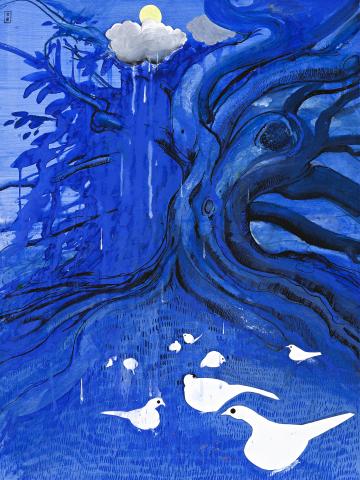SUNSHOWER, 1983
BRETT WHITELEY
gouache and collage on card
housed in the artist’s original acrylic frame
68.0 x 51.5 cm (sheet)
195.0 x 67.0 cm (frame)
signed on frame verso: Brett Whiteley
stamped with studio stamp upper left
Australian Galleries, Melbourne
Robin Gibson Gallery, Sydney
Private collection, Adelaide
Sotheby’s, Melbourne, 22 – 23 November 1999, lot 76
Company collection, Sydney
Private collection, Sydney
Life and Death: A Visual Experience in Opposites -1983 – Brett Whiteley, Australian Galleries, Melbourne, 1983, cat. 39 (illus. in exhibition catalogue)
Interestingly, when Sunshower, 1983 was first unveiled in ‘Life and Death: A Visual Experience’ at Australian Galleries in 1983, such lyrical pastorals were juxtaposed alongside Whiteley’s more tortured explorations of the Vincent Van Gogh theme. Diametrically opposed in their absence of either artifice or angst, these works represented a peaceful antidote to his darker, more laboured musings – thus tangibly embodying the complex duality that so distinguishes his oeuvre. As Sandra McGrath elucidates, Whiteley frequently journeyed between poles: ‘…in truth he was living out one of his constant themes – good and evil, optimism and pessimism, New York and Fiji, Christie and the Zoo series, the Vultures and Piero all meshed into one overall psychological and pictorial design, one lifelong attempt to reconcile extremes, one eternal battle to identify the truth that E.M. Forster recognised as being accessible only by experiencing opposites.’1
Far removed from the frenetic, politically-charged compositions of previous years, Sunshower offers rather the promise of tranquillity and happiness; ‘an art based on the idea of extraordinary escapism, a world external from the quagmire…’2 With Nature now his muse, Whiteley felt he could not only escape the greed and corruption plaguing Western civilisation but moreover, he could transcend the perceived banality and mediocrity of his contemporaries ‘…to reach a state that was more extraordinary and that allowed the imagination to exist’.3 Thus embracing the romanticism of his spiritual and artistic heirs such as Rimbaud, Van Gogh and Baudelaire, Whiteley here also pays homage to Chinese and Japanese aesthetics – in his exploration of nature as a metaphor for human experience, as well as stylistically in the sweeping calligraphic curves of his signature Moreton Bay fig. Similarly, the dominant palette of rich ultramarine recalls both Matisse and the artist’s own sumptuous Lavender Bay views, while the inclusion of several white doves poignantly evokes the serenity of the bird kingdom which had always held special appeal for Whiteley, suggesting connotations of peace and salvation.
A stunning example of his ‘Baudelairean poems of the landscape’ as Whiteley so affectionately described such visions, Sunshower celebrates nature at its most luxuriant and fecund. Imbued with an overwhelming sense of freedom, optimism and indulgent sensuality, indeed the work encapsulates the very essence of Whiteley’s art, as eloquently articulated by Edmund Capon in his ‘Preface’ to the artist’s retrospective in 1995; ‘…Whiteley so sought the mirage of freedom. There is a sense of liberation in his art which is captured in that unequivocal delight in the experience of the moment… the satisfaction and fulfilment of the moment. Whiteley’s investigations have no profounder aspirations than to immortalise the experience, and this he achieves with unrelenting imagination, individuality and ultimately an immense and humane beauty…’.4
1. McGrath, S., Brett Whiteley, Bay Books, Sydney 1979, p. 94
2. Ibid.
3. Ibid.
4. Capon, E., ‘Preface’ in Pearce, B., Brett Whiteley: Art and Life, The Art Gallery of New South Wales, Sydney, 1995, p. 7
VERONICA ANGELATOS
